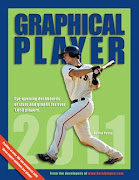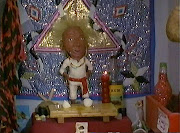 Welcome to Cleveland, Manny Acta.
Welcome to Cleveland, Manny Acta.Only 35 games into his inaugural season as Cleveland’s manager, Acta had two of the three normally reliable players on his roster taken away. With shortstop Asdrubal Cabrera out until at least late July (8-10 weeks was the formal diagnosis, excluding minor league rehab time) and center fielder Grady Sizemore benched with a bum knee that may require surgery (he's soliciting second and third opinions from specialists this week), things are looking grim for the Tribe.
That’s not to say things were going according to plan beforehand, but few teams would be expected to fully recover after the loss of two cornerstone players (especially a team that’s already dug itself a bit of a hole in the standings).
You have to give Acta credit though, he’s maintained a positive attitude throughout, hoping it rubs off on the rest of the team as they try and find their way out of the basement (or at least to the top of the stairs).
"I choose to have a good attitude,” Acta explained, “You have to lead by example. If you come dragging in with your head down, you send the wrong message." It may sound like the usual dose of manager rhetoric (formerly referred to in this space as ‘Wedge Speak’), but the way Acta communicates and projects himself provides a stark contrast with his predecessor.
Acta’s main goal, especially with the younger players, is to hammer home the fundamentals (defense, smart base running, throwing strikes). Parts of his message have already translated to the field (fewer errors being committed), while others aren’t quite there (last in the AL in first-pitch strike percentage). However, I think the reason Acta will ultimately be successful is that the players see the enthusiasm and sincerity in how he approaches his job and it leaves them wanting to meet those expectations. They want to match Acta’s passion for the game and put forth their best effort.
I think Acta’s communication skills (in English or Español) and advanced knowledge of the game will allow him to engage and encourage his players in a way that Eric Wedge could not. Eventually, Wedge’s rigid system broke down under pressure and the team lost faith in his leadership. Acta has yet to be tested in a high stakes season (expectations for 2010 were understandably low), but it will be interesting to see how this team responds to pressure situations under his watch.
For now, Acta is tasked with installing his system and evaluating and developing personnel for the future. I’m confident Cleveland’s new manager has the team on the right track, even if recent trends have been disconcerting (to put it lightly).
The current challenge is to assemble a productive offense around Shin Soo Choo, some veteran spring training invitees, and a bunch of kids not yet accustomed to hitting in the Majors. As daunting as that may sound, I’m of the opinion that the day-to-day batting order doesn’t matter nearly as much as providing the players with a defined role and the appropriate amount of playing time.
Acta has expressed his desire to win, but understands that “we have to develop players too.” The skipper recognizes the value in the remaining three-quarters of the season to further develop a young, largely inexperienced, and not quite cohesive unit into a respectable squad for the second half of 2010 and beyond. So what can we expect as far as playing time, minor league call-ups, and roster management while Cabrera and Sizemore are sidelined?
Jason Donald will be the Tribe’s starting shortstop for the foreseeable future. Donald, acquired from Philadelphia as part of the Cliff Lee package, had zero experience at the major league level before his debut on May 18. Donald had built a strong case for a promotion in Triple-A Columbus this season, compiling a .277/.396/.423 line with 10 doubles, 2 triples, 2 homers, and 10 stolen bases in 165 PA. With Luis Valbuena’s game coming apart at the seams (54 OPS+, 5 errors on the season), Donald was already on the fast track for a promotion.
Valbuena’s performance and the sudden injury to Cabrera paved the way for Donald to be named starter, ready or not. Spring training invitee Mark Grudzielanek had already earned the everyday second baseman’s gig of his own merit, leaving Valbuena in a reduced role as utility infielder.
The veteran Grudzielanek provides a significant upgrade over Valbuena in every aspect of the game, except power (which is irrelevant, since Valbuena’s power stroke has yet to return). Grudz may be a journeyman at this point in his career, but he still has an above-average glove and had a .345 OBP in 2008 (he missed most of 2009 due to a back injury).
Acta’s initial endorsement of Valbuena as the team’s second baseman at the start of the season looks hollow in hindsight. Valbuena already had one foot out the door prior to Donald’s arrival, but the organization isn’t ready to give up on him. Valbuena will continue to see a start or two each week, likely confined to second base, to allow him to work through his funk at the plate. Even if they fall into a slump, Donald and Grudzielanek’s defense will keep them in the lineup.
Andy Marte is due to come off the DL next week, but a lack of extra middle infielders (Peralta will not be playing short, says Acta) on the 25-man roster may see the recently recalled Shelley Duncan (currently occupying Sizemore’s roster spot) get sent down instead of Valbuena. Remember, Marte is out of minor league options.
Trevor Crowe was actually called up to spell Marte, but his fate is now tied to that of Sizemore’s knee. Crowe had been on the coaching staff’s radar after a memorable effort in spring training, only to lose the fourth outfielder gig to Michael Brantley (who appeared in a grand total of 9 games).
Some fans may be wondering why Trevor Crowe got called up instead of Brantley. Crowe’s promotion was initially in response to Andy Marte’s injury, meaning the team wasn’t planning on keeping him up for more than a couple weeks. The organization wanted Brantley (and Donald for that matter) to continue seeing everyday at-bats in Triple-A, so they were passed over. When Crowe caught fire in Cleveland, he gave little reason for the club to demote him even after the prognosis on Sizemore’s knee got worse. Why mess with a good thing?
Personally, I’m glad the team stuck with Crowe. There are too many first-round picks wasting away in Triple-A in this organization. If Crowe has something to offer, the team couldn’t have been handed a better opportunity to find out. Crowe is 26 years old, already has 202 major league PA under his belt, and center field is wide open. Sure he may not be as talented as Brantley, that’s not the point. There are only so many at-bats to go around and a line of young players in need of an extended look. Crowe deserves this opportunity more than Brantley, in my opinion.
Under normal circumstances, Acta views the switch-hitting Crowe as an ideal fourth outfielder, able to provide excellent defense and speed off the bench. Instead, he’s been anointed the leadoff hitter and everyday center fielder. Crowe has responded to the organization’s vote of confidence in a big way, with a slash line of .324/.390/.432 with 12 H, 4 BB, and 3 SB in his first 9 games (41 PA) entering Monday’s series against Chicago. The 26-year-old Crowe is currently outperforming his career line of .276/.354/.407 at Triple-A. Combined with a .355 BABIP, Crowe is probably playing over his head right now. As long as he’s hitting though, that leadoff spot is his.
It’s not like the team has any clear cut leadoff hitters anyway. Grudzielanek? Donald? Choo is far-and-away the best available hitter, but someone has to drive in the runs. Plus, it would be a waste to have Choo’s power batting leadoff. Instead, Acta has tapped Choo to continue his noble “bat Sizemore second” experiment (a brilliant move I’ll continue to defend, if only Sizemore had hit…). Choo’s response? Two taters in three games, so far.
Proposed Cleveland Lineup
| Order | Starter (sub) | GS (PA) | wOBA^ | ISO | WAR |
| 1 | T. Crowe# | 8 (41) | .375 | .108 | 0.4 |
| 2 | S. Choo* | 42 (190) | .405 | .176 | 2.1 |
| 3 | J. Peralta | 39 (167) | .323 | .160 | 0.2 |
| 4 | T. Hafner* | 37 (160) | .363 | .145 | 0.7 |
| 5 | A. Kearns | 29 (130) | .383 | .183 | 1.1 |
| 6 | R. Branyan* | 19 (84) | .319 | .219 | 0.3 |
| 7 | M. Grudzielanek | 20 (95) | .283 | .000 | 0.2 |
| 8 | L. Marson | 29 (106) | .247 | .042 | -0.1 |
| 9 | J. Donald | 6 (23) | .148 | .000 | -0.2 |
| (M. LaPorta) | 24 (106) | .249 | .061 | -0.5 | |
| (L. Valbuena*) | 25 (102) | .250 | .107 | -0.4 | |
| (M. Redmond) | 13 (49) | .269 | .091 | -0.2 | |
| DL | (A. Marte) | 8 (32) | .338 | .208 | 0.1 |
| DL | G. Sizemore* | 31 (140) | .255 | .078 | -0.4 |
| DL | A. Cabrera# | 33 (149) | .303 | .081 | -0.1 |
*Lefty; #Switch
^League average is roughly .335
Stats courtesy of FanGraphs, current as of 5/24/10
The rest of the lineup that’s been trotted out for the past 9 games has been fairly conventional. Speed at the top, power in the middle, light weights and scrubs at the bottom. The speedy Jason Donald is sort of the “second” leadoff man batting ninth, similar to how Brantley was deployed at the start of the season. Meanwhile, Peralta really shouldn’t be batting lower than fourth now that he’s broken out of his usual April doldrums (this opinion subject to change in 30 days).
The bottom half of the lineup is almost a throw-away with Grudzielanek setting the table for the punch-less LaPorta and Marson. The heart of the order isn’t too bad though, assuming Hafner’s bat continues to come around, Kearns doesn’t become a black hole when the inevitable regression hits (.421 BABIP!), and Branyan does….well, I guess the home runs are nice. I’m pretty comfortable with a lineup starting off with [Hot Hand of the Month], Choo, Peralta, Hafner, Kearns, and Branyan. You know, considering the circumstances. Cleveland’s lineup isn’t about to send Francisco Liriano running for the hills, but it might make Luke Hochevar break a sweat (those complete games are hard work).
Again, the lineup doesn’t really matter much in the long run. Acta might be able to eke out some extra runs by shuffling the batting order and playing the splits, but consistency and playing time are the name of the game for a young ball club trying to get its act together. Not to mention, the makeup of the offense could be in line for a dramatic overhaul once Carlos Santana comes to town. Remember what a difference it made when Victor Martinez went down with an injury in 2008? Ok, maybe you don’t because Kelly Shoppach had a career year and belted 21 homers as a catcher. Still, it’s going to be a big deal when Santana arrives in June.
Quotable Acta
When asked whether it's tough to get reliever Rafael Perez enough work in non-pressure situations:
"Life is tough. Get a helmet."
When asked about the loss of his number 1 and 2 hitters a week later:
“Life is tough, get a double-flap helmet. It provides more protection from both sides.”















